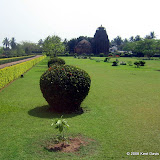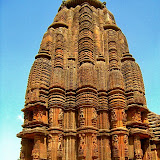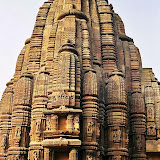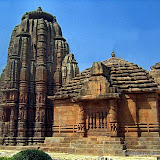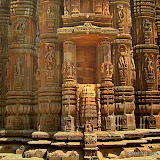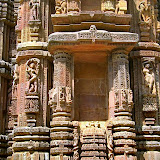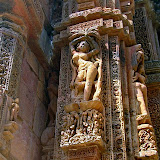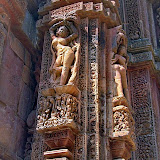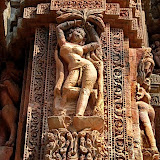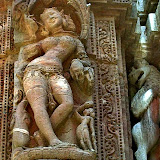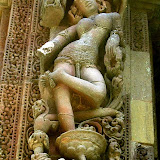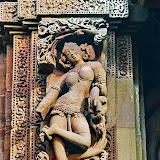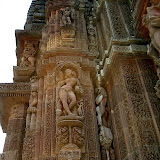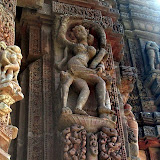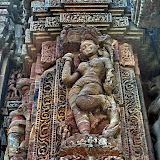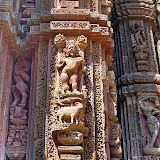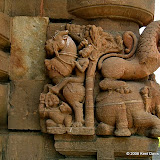Rajarani Temple Indian Devata of Orissa
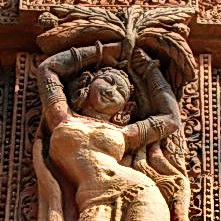
Bhubaneshwar, Orissa – Set like a gem among fertile ricefields, the 11th century Rajarani Temple is a breathtaking example of of Orissan style. It is also an immediate architectural predecessor of the Khmer Empire’s greatest monuments.
As at Angkor Wat, the Bayon, Preah Khan, Thommanon, Ta Som and other Khmer temples, we find female images as the majority of figures on Rajarani’s main structure. Playful celestial nymphs, devata, apsara or yaksini, dance upon lotus buds, framed by lush plants and foliage. Unlike the subdued “courtly devata” of the Khmers, these maidens are quite playful, and we see them engaged in romantic dalliance, enticing visitors, holding pet birds, adjusting jewelry, cradling children and gazing at themselves in mirrors. Rajarani Temple Indian Devata of Orissa
The Dikpalas: Guardians of the Eight Directions Rajarani Temple Indian Devata of Orissa
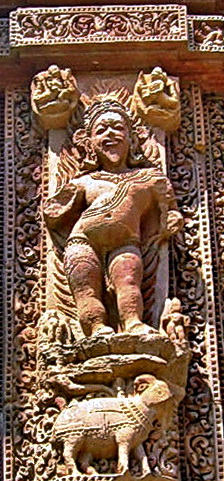
In addition to these heavenly beauties, the temple features eight “dikpalas”: guardians protecting the tower at the compass points. The guardians begin with the head of the demigods Indra in the east; Agni the god of fire (southeast); Yama god of death (south); Nirriti goddess of the black asuras, also known as Kali, (southwest); Varuna the god of water (west); Vayu the god of air (northwest); Kubera the god of weath shown with a wish-granting tree (north); and Īśāna, the face of Siva and master of all knowledge (northeast).
Northeastern Thailand, a region whose strong people were shaped by Khmer influence, is still to this day called Isaan, derived from Īśāna, the Hindu god of the northwest.
Like their Indian counterparts, Khmer temples were designed to incorporate alignment to certain compass points, however there are surprising variations. Asger Mollerup, a Danish author, linguist and archeo-astronomer, clearly establishes that the Khmers (like the ancient Indians, Chinese and Greeks) had a grasp of planetary movements far beyond what modern people believe they had. Circa 1,000 AD, the Khmers were familiar with the astronomical principles detailed in the Surya Siddhanta.
His article from the Thai site Muang Borarn Journal, considers the orientation of the Khmer temple of Phanom Rung in relation to celestial events. For a wealth of additional information, consult Mollerup’s research website, Sundial, Calendar & Khmer Temples, including this article about the “Navagraha,” or celestial deities of directions, that he examines in a number of Khmer temples.
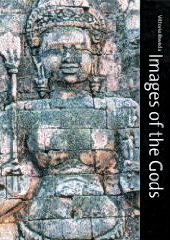
Other astronomical research relating to Khmer temples by Jean-Pierre Lacroix and Robert Bywater is available at their site AncientCartography.net.
How divine images of Hindu gods and symbols in Khmer monuments relate to compass point associations is therefore an interesting area of inquiry. In his book, Images of the Gods, author and researcher Vittorio Roveda points out the surprising fact that Angkor Wat contradicts the Hindu rules of guardian placement: the gods there actually appear opposite from their prescribed locations. Roveda’s theory is that the temple designers and iconographers envisioned a mirror image in their construction plan, for reasons that are still unknown.
The chart below may inspire readers to make some new discoveries:
| Name | Direction | Weapon | Consort | Graha (Planet) |
Guardian Matrika |
| Kubera | North | Gadā (mace) |
Kuberajāyā | Candra (Moon) |
Kumari |
| Yama | South | Daṇḍa (staff) |
Yami | Brihaspati (Jupiter) |
Varahi |
| Indra | East | Vajra (thunderbolt) |
Śacī | Sūrya (Sun) |
Aindri |
| Varuṇa | West | Pāśa (noose) |
Nalani | Śukra (Venus) |
Varuni |
| Īśāna | Northeast | Triśūla (trident) |
Parvati | Rāhu (North Lunar Node) |
Māheśvarī |
| Agni | Southeast | Śakti (Spear) |
Svāhā | Maṅgala (Mars) |
Meshavahini |
| Vāyu | Northwest | Aṅkuśa (goad) |
Bharati | Śani (Saturn) |
Mrigavahini |
| Nirṛti (or Kali) |
Southwest | Khaḍga (sword) |
Khaḍgī | Budha (Mercury) |
Khadagadharini |
| Viṣṇu | Zenith | Cakra (discus) |
Lakṣmī | Lagna | Vaishnavi |
| Brahmā | Nadir | Padma (lotus) |
Sarasvatī | Ketu (South Lunar Node) |
Brahmani |
Adapted from Wikpedia “The Guardians of the Directions”
Ancient Angels and Modern Cambodian Dance
Above the figures of the major Rajarani gods we see flying angels. What’s curious is that these angels are in the identical pose that the ancient Cambodian dance traditions uses to symbolize flying to this very day! This inspired this article about the history of divine flight. If the link is not yet active, the article isn’t complete, but will be soon.
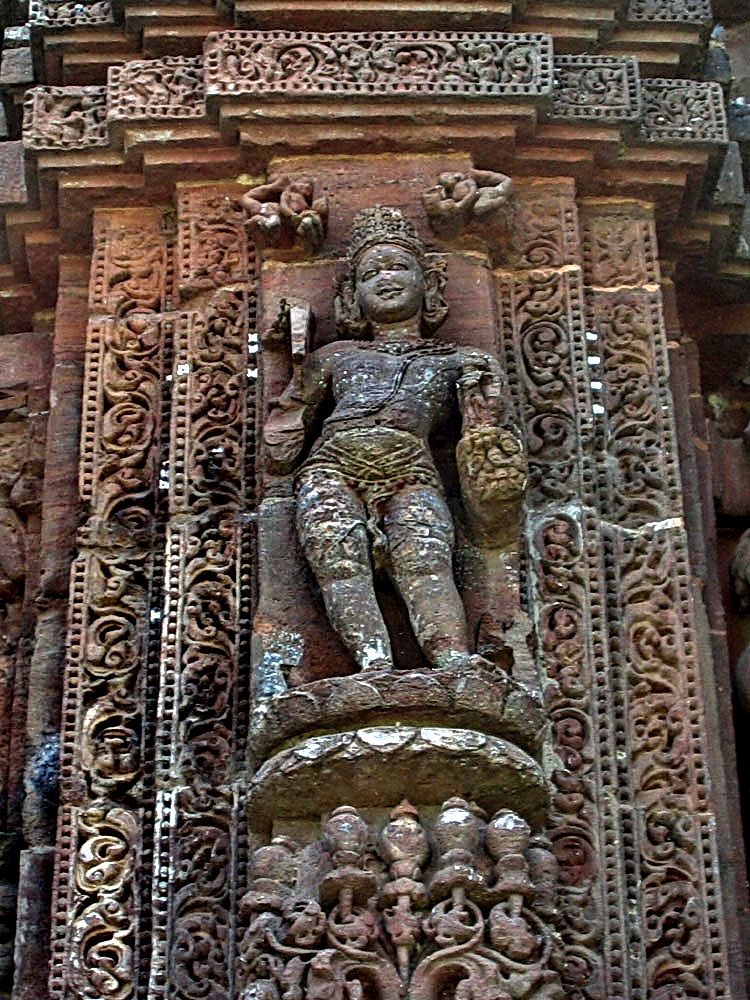
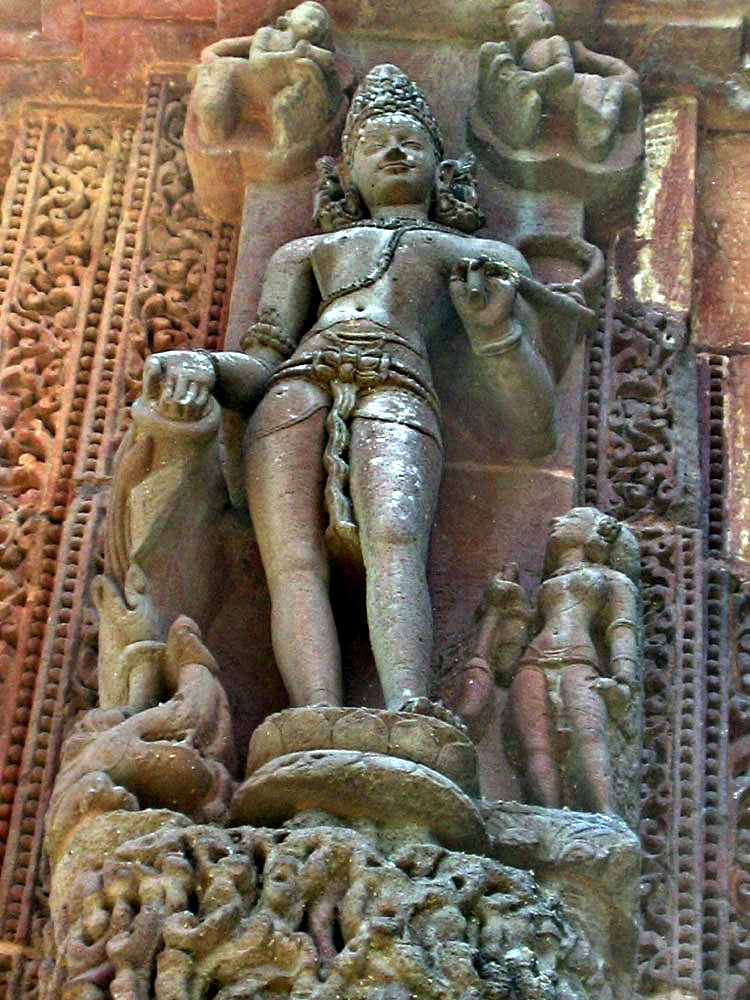
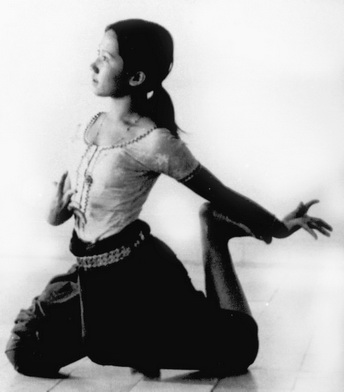
The Origin of Rajarani’s Name
In this region of Orissa, “rajarani” is the local name of the rich red and gold sandstone that the temple is made from. However, there is a debate about the temple’s name that is inspired by the name of the city Bhubaneswar itself: all Hindu temples dedicated to the God Shiva in that town end in the suffix “eswar.” Non-Shaivite temple names are based on the presiding deity (e.g. Parvati temple).
The Orissan king who built Rajarani temple died before the temple was complete. The ceremony to install the main deity was therefore never performed, leaving Rajarani eternally godless. At least one scholar has argued that the Rajarani name was applied at a much later date because of the local stone used, and that this shrine was originally built to honor Shiva, like many others in the town.
Rajarani temple is an extraordinary statement to the brilliance of the Indian architects, builders and spiritual leaders of Orissa. I hope I am one day able to supplement the modest gallery below:

